



External Parasites of Poultry
By P. E. Kaufman, P. G. Koehler and J. F. Butler - University of Florida, IFAS Extension. Arthropods are important pests of poultry in Florida, especially where proper management practices are not implemented.Lice and mites are the most common pests of poultry in Florida, although the fowl tick and the sticktight flea may also cause serious problems. Though not a parasite of poultry, the house fly is a major concern to poultry producers, especially in caged-layer operations.
Chewing Lice
Chewing lice (or biting) are small, wingless, flattened insects with a broad head. All the chewing lice have similar life cycles. Their entire lives are spent on the host and, except for occasional clinging to flies, biting lice are transmitted from generation to generation on the same host species. Lice are highly host specific and are usually not transmitted from wild to domestic birds. Sucking lice do not occur on birds.
Lice tend to be more of a problem in household flocks than commercial flocks, as commercial breeders do not permit parent-offspring contact. In backyard flocks the hen incubates the egg and cares for the chick. Thus, louse populations are easily transmitted from one generation of chickens to the next.
The development of the common pigeon louse exemplifies the typical life cycle of poultry lice. As many as 60 eggs are glued to the host's feathers by the adult female louse. The eggs have an incubation period of from 3 to 5 days if the temperature is optimal. Nymphs hatch from the egg and pass through three nymphal instars, each lasting approximately 7 days. The third stage nymph then molts to the adult stage. It usually takes 30 days to grow from egg to adult.
Biting lice do not suck blood from their host bird; however, they may ingest blood from irritated skin. Normally, bird lice feed on the protective sheaths of growing feathers, feather fibers, down, skin, scabs, blood, mucous and even their own eggs and cast-off skins. Infested birds exhibit skin irritation, damaged plumage and generally poor condition. Young birds often die from the invasion of secondary infections. The most serious effect on older birds is the reduction in egg production.
In Florida, the major lice that attack poultry are the shaft louse, the fluff louse, the wing louse and the chicken head louse.
Shaft, Fluff and Wing Lice
The shaft louse ( Figure 1 ) is the most serious louse pest of chickens. It feeds on the barbs and scales of the feathers, causing little host irritation. It is usually not found on young chickens because of their lack of well-developed wings. The adults, nymphs and eggs are found on the feathers and generally damage the plumage. The shaft louse also will infest ducks, turkeys and guinea hens if they are housed close to infested poultry.

CREDITS: J. F.Butler, University of Florida
Figure 1. Shaft louse.
The fluff louse is a small louse species approximately 1 mm in length. It is found among the fluff under the vent, where it feeds on the fluff.

CREDITS: J. F.Butler, University of Florida
Figure 2. Wing louse.
The wing louse ( Figure 2 ) is found among the barbules of the wing feathers of young and old birds. When heavy infestations occur, areas of the host's skin are made bare. Infested birds commonly scratch themselves with their claws, causing intense irritation.
Chicken Head Louse
The chicken head louse constantly nibbles at the skin scales ( Figure 3 ) and is a serious pest of young chickens and turkeys. It is frequently found on the head and neck of poultry.

CREDITS: J. F. Butler, University of Florida
Figure 3. Chicken head louse.
Lice become a problem when proper maintenance practices are not routinely followed. In all cases, good louse control can be attained with the application of sprays or dusts to the birds. Because lice rarely leave birds, premise treatment is of little value in louse control operations.
Mites
The mites that attack poultry have similar life cycles, with four stages -- egg, larva, two nymphal stages and adult. The nymphs and adults have piercing-sucking mouthparts and take blood meals from birds.
Several mite species can be found on poultry in Florida; however, the most important mite is the northern fowl mite. Other mites such as the red chicken mite and the tropical fowl mite occasionally cause severe problems.
Northern Fowl Mite
The northern fowl mite ( Figure 4 ) is a common external parasite of domestic fowl and wild birds throughout the temperate regions of the world. It has been shown to produce economic damage by causing anemia, lowering egg production and weight gain, and causing bird death. The mites will also bite man, causing itching and irritation to the skin.
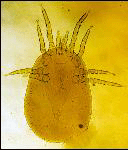
CREDITS: J. F. Butler, University of Florida
Figure 4. Northern fowl mite.
The adult female mite lays eggs on the host bird. Depending on the temperature and humidity, the eggs will hatch in 1 to 2 days. The larvae that hatch from the egg do not feed, and molt to the nymphal stage in about eight hours. The nymph has biting mouthparts and pierces the host bird's skin for a blood meal. The nymphs mature to adults in 4 to 7 days.
Adult female mites take a blood meal and complete egg laying in two days. The number of eggs laid average 2 to 5 per female mite. The complete life cycle from egg to egg-laying adult can take place in 5 to 7 days or longer, depending on temperature and humidity. Adult mites spend most of their lives on the host but will also wander from the birds. The preferred site on the host is the vicinity of the vent although the back is also a preferred site.
Although female mites do not lay large numbers of eggs, mite populations can rise rapidly after a bird has been initially infested. When conditions are optimal, newly-infested birds may support mite populations in excess of 20,000 per bird in 9 to 10 weeks. Mite populations of approximately 200,000 per bird may cause death from blood loss or exsanguination. Mite populations vary seasonally with the largest populations in mid-winter.
Mite control is easily realized if reapplication of insecticides is made in 4 to 7 days.
Common Red Chicken Mite
The common red mite ( Figure 5 ) is found on domestic fowl throughout the world, parasitizing chickens, turkeys, pigeons, wild birds and occasionally man. Older fowl exhibit similar symptoms of infestation as those parasitized by northern fowl mite. Young chickens will usually die when attacked by this mite. The red mite also serves as the vector for avian spirochetes.
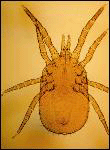
CREDITS: J. F. Butler, University of Florida
Figure 5. Red chicken mite.
The red mite hides in cracks and crevices during the day and crawls onto the host at night for a blood meal. The life cycle is similar to the northern fowl mite and also can be completed in as little as 7 days. Premise treatment as well as bird treatment aids in the control of this mite since much of its life is spent off the host.
Tropical Fowl Mite
The tropical fowl mite ( Figure 6 ) is widely distributed in South America, the Caribbean and southern United States. It is a mobile species and will feed during the day or night. Besides domestic fowl, the tropical fowl mite prefers English sparrows and transmission from wild birds to domestic fowl are quite common.
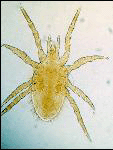
CREDITS: J. F. Butler, University of Florida
Figure 6. Tropical fowl mite.
Fowl Tick
The fowl tick ( Figure 7 ), also called the blue bug, injures poultry by blood feeding, causing weight loss, blemishes, and lower egg production. The tick is especially difficult to control since it hides near the roosts of birds during the day. At night, however, the nymphs and adults climb onto the birds and engorge themselves with blood.
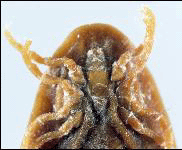
CREDITS: J. F. Butler, University of Florida
Figure 7. Fowl tick.
The female tick lays 25 to 100 eggs at one time in clumps, and one female may produce as many as 700 eggs in her lifetime. The eggs hatch in 1 to 4 weeks into larvae that climb onto the birds for a blood meal. The larvae remain on the host up to five days, until fully engorged. The feeding sites become severely irritated after extended feeding. The larvae drop off the host and molt into the nymphal stage about 7 days after hatching. The nymphs blood-feed and molt 3 to 4 times before maturing to the adult stage. After each feeding the tick returns to its hiding place. At night there is often movement of large numbers of ticks from hiding places to hosts and back.
The fowl tick can live for extended periods of time without a blood meal. Therefore, leaving facilities vacant for a long period of time will usually not eliminate a population.
Sanitation is the best control of the fowl tick. Thorough spray applications of pesticides will help control ticks, but are not completely effective. Fowl tick problems require persistence to reduce widespread fowl tick problems.
Sticktight Flea
The sticktight flea ( Figure 8 ) can be a severe poultry pest in Florida. Symptoms of infestations are dark-brown spots on the face, comb, and wattles where the fleas are embedded in the skin. Young fowl can be killed and other fowl may reduce egg production as a result of the irritation and blood loss.
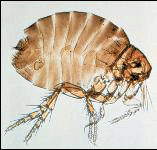
CREDITS: J. F. Butler, University of Florida
Figure 8. Sticktight flea.
The adult males and females of the sticktight flea are usually found on the heads of fowl. The females remain attached for 2 to 3 weeks. The female lays eggs that fall to the ground and hatch into larvae which feed on organic matter. Within 2 to 4 weeks the larvae pupate. The life cycle is completed in 1 to 2 months. Usually these fleas are more prevalent in the cooler months of the year.
House Fly
A poultry farm cannot be kept entirely free of house flies. In caged-layer poultry operations, where conditions for house fly ( Figure 9 ) development are ideal, it is extremely difficult to prevent breeding. However, by using good management practices and the proper use of selective insecticides, the flies can be managed at a lower level than is found in many poultry operations.
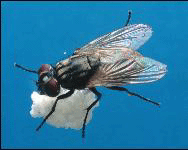
CREDITS: J. F. Butler, University of Florida
Figure 9. House fly.
House fly eggs are laid in almost any type of warm organic material; however, poultry manure is an excellent breeding medium. Fermenting vegetation such as grass clippings and garbage also provide a medium for fly breeding. The white eggs, which are laid in clusters of 75 to 100, hatch within 24 hours into minute larvae or maggots. In 4 to 6 days the larvae migrate to drier portions of the breeding medium and pupate. The pupal stage may vary in duration considerably, but in warm weather can be about three days.
When the adult emerges from the puparium, the wings are folded in tight pads. The house fly crawls about rapidly while the wings unfold and the body dries and hardens. Under normal conditions this may take as little as an hour. A house fly may go through an entire life cycle - egg, larva, pupa to winged adult - in 6 to 10 days under Florida conditions. An adult house fly may live an average of 30 days. During warm weather 2 or more generations may be produced per month. Because of this rapid rate of development and the large number of eggs produced by the female, large populations develop.
House flies are strong fliers and can become widely distributed by flying. Generally, however, flies are abundant in the immediate vicinity of their breeding site. Under certain conditions, they may migrate 1 to 4 miles, but are more usually limited to one-half to 1 mile.
Insecticide Resistance
Resistance is a complex problem associated with chemical control of insects. Recognized some 50 years ago, it is not a new problem. Defined, resistance is the ability of an insect population to withstand exposure to insecticides. This is acquired by successful breeding from those insects that survived previous exposures to an insecticide. The surviving insects are resistant because either biochemical mechanisms (enzymes) enable them to quickly break down the insecticide, physiological changes to internal structures (so the insiticide cannot bind to the correct site), or behavioristic adaptations enable them to somehow avoid the insecticide.
Control of Poultry Ectoparasites
Insecticides should be considered the last resort after sanitation and management methods have been tried. Sole reliance on insecticides often results in resistance, control failures and higher pest populations due to a lack of biological control organisms.
Precautions in Pesticide Application
Although pesticides are used to protect poultry from pests, it is important to remember that any pesticide should be considered an active poison. Follow these suggestions to apply pesticides safely:
- Always read and follow label directions. The label should be read both before purchasing a pesticide and before applying a pesticide. At the time of purchase the label should be read to determine if the product can be used as desired, if the formulation is proper for the job, and if the right application equipment is available. Law requires that labels on poultry insecticides clearly state "For Use On Poultry." Before applying the pesticide, the label should be read again to determine the necessary protective equipment, special warnings and first aid measures, correct mixing, rate of application, when to apply, and restrictions on its use.
- Keep pesticides out of reach of children, pets, irresponsible people and livestock. Pesticides should be stored in a locked area outside the house away from food or feed.
- Keep pesticides in their original containers. Dispose of empty containers promptly and safely.
- Never use more insecticide than is recommended. Overdoses of pesticides not only are potentially fatal but also can weaken birds and predispose them to disease. Young birds because of their low body weight are particularly susceptible to overdose of some pesticides.
- Pesticides should not be applied in combination with other pesticides or drugs because the combination of chemicals may produce undesirable effects.
- Protect yourself from the effects of pesticides. Never smoke, eat or chew while spraying or dusting. Avoid inhaling sprays or dusts. If pesticides are accidentally spilled on skin or clothing, remove contaminated clothing immediately and wash contaminated skin thoroughly.
- Bathe, washing face and hands thoroughly, and change to clean clothing after pesticide application. Wash clothes before re-use.
- If symptoms of illness occur during or shortly after spraying, call a physician and take the pesticide label to the hospital with the patient.
- Do not use your mouth to siphon liquids from containers or to blow out clogged lines or nozzles.
- Do not spray with leaking hoses or connections.
- Do not work in the drift of a spray or dust.
- Bathe, washing face and hands thoroughly, and change to clean clothing after pesticide application. Wash clothes before re-use.
- Eggs should be gathered before spraying or dusting birds with pesticides.
- Do not contaminate feed or water during pesticide application.
Residues
Poultry producers are cautioned against the use of anything but recommended materials for insect control. The use of any insecticide not clearly labeled "For Use On Poultry" can lead to illegal residues in meat or eggs, resulting in seizure, economic loss, and a tarnished image of the industry.
To avoid excessive residues, use the insecticides recommended, at the time recommended, and in the amounts recommended.
Formulations
Poultry producers are cautioned against the use of anything but recommended materials for insect control. The use of any insecticide not clearly labeled "For Use On Poultry" can lead to illegal residues in meat or eggs, resulting in seizure, economic loss, and a tarnished image of the industry.
To avoid excessive residues, use the insecticides recommended, at the time recommended, and in the amounts recommended.
House fly control with chemicals can be divided into several groups: feed-through larvacides, residual sprays, space sprays or fogs, baits, and larvicides.
Dry baits should be applied twice weekly from late spring to fall. Bait applications attract and kill adult flies that are around the poultry house. Baits consist of an insecticide applied to sugar with other fly attractants, such as pheromones, added to increase effectiveness. Baits will not effectively reduce large fly outbreaks but will eliminate a few flies that would otherwise be a nuisance. Baits should be scattered on walkways, at the ends of buildings and under feed bins where adult flies congregate. Locations for bait placement should be dry to prolong the bait's effectiveness.
Insect growth regulators have been approved for use in Florida. It is mixed into the feed at the feed mill and may be an effective method of controlling house flies. A few days after initiating birds on treated feed, house fly pupae become so deformed that adult flies cannot develop. Populations of house flies then decline in 10 to 20 days. Control is maintained as long as IGR is fed to birds and the maggots fail to develop into adult flies.
Larvicides are pesticides which are applied to waste to kill house fly maggots. The manure sprays also kill adult flies that contact recently sprayed waste.
Only waste that is breeding flies should be sprayed with larvicides. Routine applications of larvicides to the entire manure pad is not recommended because beneficial insects are killed and moisture is added to the waste. Larvicides are best applied as spot treatments to kill larvae in wet spots. Spot treatment saves money and is effective in a total management program.
Residual sprays may be effective in controlling heavy populations of adult flies. These sprays should be applied to surfaces where flies rest such as ceilings, trusses, wires supporting cages, electric light cords, and other areas with fly specking. Residual sprays should be applied with a power sprayer and low pressure. Avoid contamination of feed, water, and eggs while applying residual sprays. Flies have developed resistance to many of the pesticides found in residual sprays.
Space spraying or fogging is the application of pesticides to air in fine droplets to kill flies. Several types of sprayers are available for space spraying. These include thermal foggers, cold foggers, ULV (Ultra Low Volume) generators and automatic spray systems.
Space sprays or fogs must be applied when flies are in the poultry house since there is no residual effect. Space sprays should be applied in the evening or early morning when the air is calm and the flies are in the poultry house. Careful application can provide rapid knockdown of adult flies.
If the waste is breeding large numbers of adult flies, no reduction of adult populations may be noticed for several days.
Spray System Recommendations
- Distance of nozzles from vent of bird -- 8 inches
- Nozzle type -- 50 flat fan
- Distance between nozzles -- 8 inches (2 nozzles will cover a cage 18" deep)
- Pressure -- 80 psi
- Size of oriface -- 08
Calibration
The job of a pesticide applicator is to coordinate the gallons or lbs/min and the birds/min. The requirements of a good application are:
- A good operator.
- A delivery system of the proper type, correctly adjusted.
- Speed coordinated with the output.
Calibration is the calculation of the time to travel a distance so the correct amount of insecticide is delivered per bird. It is important to do this calculation before spraying to insure proper application.
Steps in Calibration- Measure ounces of spray solution from one nozzle per minute (2 x output per one-half min).
- Multiply ounces from one nozzle by total number of nozzles.
- Divide total number of ounces from all nozzles by 128 ounces (128 ounces = 1 gallon). This figure equals the gallons/min delivered by the spray system.
- Determine from label the number of birds one gallon of diluted spray should cover (usually 100-125 birds/gal).
- Multiply # gal/min by # birds/gal to determine the number of birds to be treated per minute.
- Determine the number of birds per linear ft of cage.
- Divide the # of birds treated/min by # of birds/linear ft.
This is the distance that must be traversed in 1 min to apply the recommended rate of insecticide.
Example: An applicator is using 2 nozzles to cover cages 10" wide and 18" deep. There are 3 birds per cage. He wants to spray carbaryl (Sevin) at the recommended 6 oz of 50% WP in 5 gal of water per 500 birds.
Step 1 -- The applicator collects 154 fl oz of spray from one nozzle in one minute.
Step 2 -- 154 fl oz x 2 nozzles = 308 fl oz/min
Step 3 -- 308 fl oz/min = 2.4 gal/min
128 fl oz/gal
Step 4 -- 500 birds per 5 gal = 100 birds/gal
Step 5 -- 2.4 gal/min x 100 birds/gal = 240 birds/min
Step 6 -- 3 birds/cage x 12 in/ft = 3.6 birds/ft.
10 inch/cage
Step 7 -- 240 birds/min = 66.7 ft/min = 3.6 birds/ft
Therefore, if the house is 300 ft in length, it should take the operator 4.5 minutes to spray one row of cages at the proper rate.
Problems with Spray Systems
Control of external parasites on poultry requires that an effective pesticide be properly applied. Besides problems with calibration and application of proper rates, lack of control can also be traced to poor application techniques.
Problems of poor application techniques usually are of two types:
- Lack of adequate coverage.
- Lack of penetrating ability.
It is difficult to get both good coverage and good penetration. For instance, a wide angle nozzle (80 -120°) gives good coverage but poor penetration. A narrow angle spray (50 - 65°) provides less coverage but greater penetration. To overcome more limited coverage, two 50° nozzles could be used to cover the same distance as one 80° nozzle.
Penetration -- The ability of a spray to penetrate the vent area is dependent upon the size of the droplet and the distance it must travel. The optimum distance a nozzle should be from the vent is 8 inches. If the nozzle is 14 inches from the vent, penetration of the spray is reduced. At 8 inches from the target, a 50° nozzle will cover 8 inches horizontally and an 80 nozzle will cover 14 inches.
Wetting Agents
The feathers of chickens are often oily, making it difficult for sprays to stick and penetrate to the skin. Surfacants or wetting agents may be added to the formulated spray to aid in breaking the surface tension of the feather.
Animal Toxicity Recognition
The initial sign of pesticide poisoning is a quieting of the bird's attitude and loss of interest in its surroundings. It will lie quietly and move very little. Toxicity symptoms usually occur within 48 hours of treatment.
The initial lethargy will usually be accompanied by diarrhea. More advanced poisoning usually exhibits difficulty in breathing. If made to move, the animal will move stiffly and stumble.
Many animals will recover without treatment if the dosage of toxicant has not been too high.
Tables
|
Table 1. Summary of Poultry Insecticide Registrations.
|
||||
| Insecticide |
Formulation |
% Active Ingredient |
Signal Word |
Pests |
|---|---|---|---|---|
| Permectrin (Permectrin II) |
Emulsifiable Concentrate |
10.0% |
Caution |
blowflies, fleas, mange mites, mosquitoes, poultry mites (Reg 09/08) |
| Permethrin (Atroban 11% EC Insecticide) |
Emulsifiable Concentrate |
11.0% |
lice, Northern fowl mites (Reg 06/09) |
|
| (Atroban 42.5% EC) |
Emulsifiable Concentrate |
42.5% |
lice, Northern fowl mites (Reg 06/09) |
|
| (GardStar 40% EC) |
Emulsifiable Concentrate |
40.0% |
Danger |
lice, Northern fowl mites (Reg 03/08) |
| Tetrachlorvinphos + Dichlorvos (Ravap E.C.) |
Emulsifiable Concentrate |
23.0% + 5.3% |
Danger |
lice, mites (Reg 09/08) |
|
Table 2. Registered Insecticides for Specific Poultry Pests.
|
|||
| Insecticide |
Formulation |
Signal Word |
Comments |
|---|---|---|---|
| Lice |
|||
| Atroban 11% EC Insecticide (permethrin) |
Emulsifiable Concentrate |
Dilute 1 qt to 50 gallons of water (6 tbsp/5 gallons). Apply one gallon of coarse spray per 100 birds, paying particular attention to vent area. (Reg 06/09) |
|
| Atroban 42.5% EC (permethrin) |
Emulsifiable Concentrate |
Dilute with clean water and apply sufficient spray (approximately 1 gal./100 birds). One application should eliminate an infestation. Do not apply more than four treatments. (Reg 06/09) |
|
| GardStar 40% EC (permethrin) |
Emulsifiable Concentrate |
Danger |
Dilute and apply 1 gal of coarse spray per 100 birds, paying particular attention to vent area. (Reg 03/08) |
| Ravap E.C. (tetrachlorvinphos + dichlorvos) |
Emulsifiable Concentrate |
Danger |
Apply diluted product according to label directions for caged chickens, chickens on litter and as roost paint. (Reg 09/08) |
| Mites |
|||
| Ravap E.C. (tetrachlorvinphos + dichlorvos) |
Emulsifiable Concentrate |
Danger |
Apply diluted product according to label directions for caged chickens, chickens on litter and as roost paint. (Reg 09/08) |
| Mites (Northern Fowl) |
|||
| Atroban 11% EC Insecticide (permethrin) |
Emulsifiable Concentrate |
Dilute 1 qt to 50 gallons of water (6 tbsp/5 gallons). Apply one gallon of coarse spray per 100 birds, paying particular attention to vent area. (Reg 06/09) |
|
| Atroban 42.5% EC (permethrin) |
Emulsifiable Concentrate |
Dilute with clean water and apply sufficient spray (approximately 1 gal./100 birds). One application should eliminate an infestation. Do not apply more than four treatments. (Reg 06/09) |
|
| GardStar 40% EC (permethrin) |
Emulsifiable Concentrate |
Dilute and apply 1 gal of coarse spray per 100 birds, paying particular attention to vent area. (Reg 03/08) |
|
| Mites (Poultry) |
|||
| Permectrin II (permethrin) |
Emulsifiable Concentrate |
Caution |
Dilute and spray 1/2 oz per bird, or 1 gal per 100 birds, directed toward vent area. Spray cages. (Reg 06/08) |
|
Table 3. Summary of Poultry House Insecticide Registrations.
|
||||
| Insecticide |
Formulation |
% Active Ingredient |
Signal Word |
Pests |
|---|---|---|---|---|
| Cyfluthrin (Tempo 1% Dust) |
Dust |
1.0% |
Caution |
ants, bees, flies, spiders, wasps (Reg12/07) |
| (Tempo 20 WP Insecticide) |
Wettable Powder |
20.0% |
Caution |
ants, cockroaches, flies, gnats, mosquitoes, spiders wasps (Reg 09/08) |
| (Tempo SC Ultra Insecticide) |
Liquid |
11.8% |
Caution |
ants, cockroaches, flies, spiders (Reg 09/08) |
| Imidacloprid (Quickbayt) |
Bait |
0.5% |
Caution |
flies (Reg 09/07) |
| Lambda-cyhalothrin (Demand CS Insecticide) |
Liquid |
9.7% |
Caution |
flies, mosquitoes, spiders wasps (Reg 12/08) |
| (Grenade ER Premise Insecticide) |
Liquid |
9.7% |
ants, bees, fleas, flies, mosquitoes, spiders, wasps (Reg 06/09) |
|
| Methomyl (Golden Malrin) |
Bait |
1.1% |
Caution |
flies (Reg 03/08) |
| Nithiazine (QuikStrike) |
Fly Strip |
1.0% |
Caution |
flies (Reg 03/08) |
| Permectrin (Permectrin II) |
Emulsifiable Concentrate |
10.0% |
Caution |
fleas, house flies, lice, mites, stable flies, ticks (Reg 09/08) |
| Permethrin (Atroban 11% EC Insecticide) |
Emulsifiable Concentrate |
11.0% |
house flies, little house flies, stable flies (Reg 06/09) |
|
| (Atroban 42.5% EC) |
Emulsifiable Concentrate |
42.5% |
house flies, little house flies, stable flies (Reg 06/09) |
|
| (GardStar 40% EC) |
Emulsifiable Concentrate |
40.0% |
Danger |
chicken mites, house flies, stable flies (Reg 03/08) |
| (Permectrin CDS) |
Pour-On |
7.4% |
Caution |
black flies, fleas, gnats, house flies, mosquitoes, stable flies (Reg 06/09) |
| Pyriproxyfen (Archer IGR) |
Emulsifiable Concentrate |
1.3% |
Caution |
ants, cockroaches, fleas, flies, gnats, litter beetles, mosquitoes (Reg 12/08) |
| Spinosad (Elector Bait) |
Bait |
0.5% |
None |
flies (Reg 06/09) |
| (Elector PSP Premise Insect Control Agent |
Liquid |
44.2% |
Caution |
darklling beetles, flies hide beetle (Reg 06/09) |
| Tetrachlorvinphos + Dichlorvos (Ravap E.C.) |
Emulsifiable Concentrate |
23.0% + 5.3% |
Danger |
flies, fowl tick, gnats, litter beetles, maggots, mosquitoes, spiders, wasps (Reg 09/08) |
December 2007








